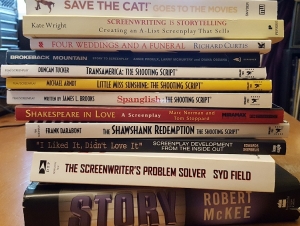Less is more. Mark Twain once said, “I didn’t have time to write a short letter, so I wrote a long one instead.” The idea is that it takes more time to really think about—and get to the heart of—what you want to say, though it’s probably easier to ramble on and on. In screenwriting, you’re constantly trimming the fat until you have nothing but the story. Every scene must serve the story in some way or it gets the axe. Authors like Faulkner might have disagreed with this, and it’s truly a decision only the writer can make. I prefer to give you just enough description to let your imagination take you somewhere and fill in the blanks. However, there are readers who want to know what everything looks like. For them I would recommend Margaret Mitchell’s classic, Gone with the Wind, in which she regales us with the details of Scarlett O’Hara’s eyelashes. It’s somewhat relevant to the story, setting up her flirty nature. But do we need a page and a half of description? I think not. If I’m reading a story about an old attic with cobwebs in the corner, that’s interesting. If the author spends pages on the description of those cobwebs, she’s lost me.My editor sometimes gives me a hard time because I’m so used to trimming the fat, that I sometimes trim important plot resolutions right out of the story! She’ll ask, “Whatever happened to so and so?” In a film, you don’t always know how every supporting character ended up, especially if they weren’t essential to the plot. But I’ve found through writing novels that readers do care what happened to everyone, and if you “cut” to that final scene, you’d better give them answers to lingering questions.
The “less is more” tip also comes in handy when crafting character descriptions. How many times have you read what a character looks like in great detail—the shiny raven hair, flashing diamond eyes, the classic Roman nose yet not-too-pointy or she’d look like a bird. . .wait. Back up. When writing a screenplay, the first time you introduce a character, you’re not only writing to assist the casting director in choosing the right “type” for the role, you’re also setting up an image in the reader’s mind, so she can see that character in the movie in her head. A succinct phrase goes a long way in creating a powerful image. In my second novel, Hurricane Days, I described Governor Robin Sanders as a late forties Scarlett O’Hara. Immediately you can presume certain physical, as well as personality, traits about her. Dark hair, from the South, stubborn and temperamental, yet strong when she has to be.
A few more examples:
“She was probably that popular cheerleader in high school who every girl wanted to be.”
“He was a walking mid-life crisis, one step away from throwing himself in front of the next subway train.”
Try it with your next character and you’ll see that it requires some thought to paint a vivid picture in your reader’s mind.
Whether it’s character, place or action descriptions, you’ll find that a few carefully chosen words can go a long way.




